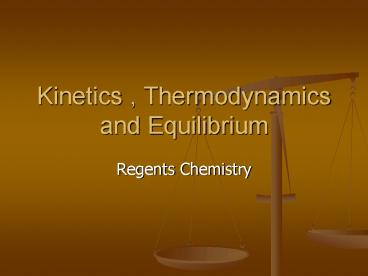Kinetics , Thermodynamics and Equilibrium - PowerPoint PPT Presentation
1 / 10
Title:
Kinetics , Thermodynamics and Equilibrium
Description:
Kinetics , Thermodynamics and Equilibrium Regents Chemistry Kinetics and Thermodynamics Kinetics: deals with rates of reactions Thermodynamics: involves changes in ... – PowerPoint PPT presentation
Number of Views:174
Avg rating:3.0/5.0
Title: Kinetics , Thermodynamics and Equilibrium
1
Kinetics , Thermodynamics and Equilibrium
- Regents Chemistry
2
Kinetics and Thermodynamics
- Kinetics deals with rates of reactions
- Thermodynamics involves changes in energy that
occur in reactions
3
Kinetics Collision Theory
- Measured in
- moles of reactant used per unit time
- Or
- moles of product formed per unit time
- Frequency of collisions more collisions faster
rate - Effective collisions must have proper
orientation and enough energy
4
Factors Affecting Rate
- 1. Type of substance
- Ionic substances react faster bonds require less
energy to break - Covalent react more slowly bonds require more
energy to break
5
Factors Affecting Rate
- 2. Temperature increase
- Kinetic energy increases and the number of
collisions increases. - Soreactants have more energy when colliding.
This increases rate.
6
Factors Affecting Rate
- 3. Concentration increase
- Increases rate due to the fact that more
particles in a container, which creates more
collisions.
7
Factors Affecting Rate
- 4. Surface Area Increase
- Increases rate by increasing reactant interaction
or collisions
8
Factors Affecting Rate
- 5. Pressure Increases
- Increases the rate of reactions involving gases
only
As pressure ? Volume ? so spaces between
molecules ? ? frequency of effective collisions
9
Factors Affecting Rate
- 6. Catalyst substance that increases rate of
reaction, lowers the activation energy of the
reaction. - Catalysts remain unchanged during the reaction
and can be reused. - Activation energy amount of energy required to
start a reaction
10
Potential Energy Diagrams
- Graphs the Change in heat during the course of a
reaction.































